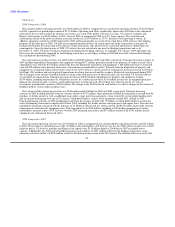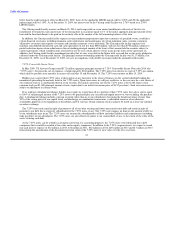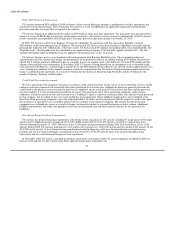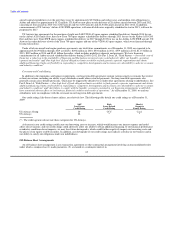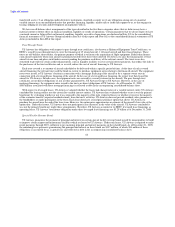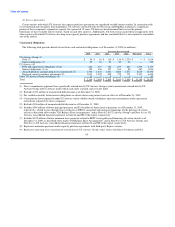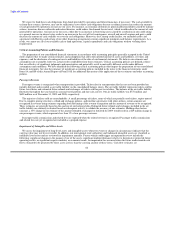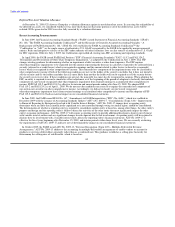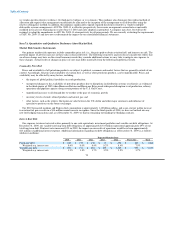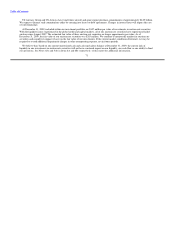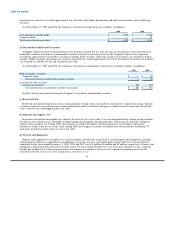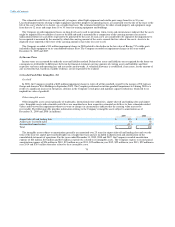US Airways 2009 Annual Report Download - page 71
Download and view the complete annual report
Please find page 71 of the 2009 US Airways annual report below. You can navigate through the pages in the report by either clicking on the pages listed below, or by using the keyword search tool below to find specific information within the annual report.
Table of Contents
Deferred Tax Asset Valuation Allowance
At December 31, 2009, US Airways Group has a valuation allowance against its net deferred tax assets. In assessing the realizability of
the deferred tax assets, we considered whether it was more likely than not that some portion or all of the deferred tax assets will be
realized. NOLs generated in 2009 were also fully reserved by a valuation allowance.
Recent Accounting Pronouncements
In June 2009, the Financial Accounting Standards Board ("FASB") issued Statement of Financial Accounting Standards ("SFAS")
No. 168, "The FASB Accounting Standards CodificationTM and the Hierarchy of Generally Accepted Accounting Principles – A
Replacement of FASB Statement No. 162." SFAS No. 168 establishes the FASB Accounting Standards CodificationTM (the
"Codification" or "ASC") as the single source of authoritative U.S. GAAP recognized by the FASB to be applied by nongovernmental
entities. Rules and interpretive releases of the SEC under authority of federal securities laws are also sources of authoritative U.S. GAAP
for SEC registrants. Effective July 1, 2009, the Codification superseded all existing non-SEC accounting and reporting standards.
In April 2009, the FASB issued FASB Staff Position ("FSP") Financial Accounting Standards ("FAS") 115-2 and FAS 124-2,
"Recognition and Presentation of Other-Than-Temporary Impairments," as adopted by the Codification on July 1, 2009. This FSP
changes existing guidance for determining whether an impairment of debt securities is other-than-temporary. The FSP requires
other-than-temporary impairments to be separated into the amount representing the decrease in cash flows expected to be collected from a
security (referred to as credit losses) which is recognized in earnings and the amount related to other factors (referred to as noncredit
losses) which is recognized in other comprehensive income. This noncredit loss component of the impairment may only be classified in
other comprehensive income if both of the following conditions are met (a) the holder of the security concludes that it does not intend to
sell the security and (b) the holder concludes that it is more likely than not that the holder will not be required to sell the security before
the security recovers its value. If these conditions are not met, the noncredit loss must also be recognized in earnings. When adopting the
FSP, an entity is required to record a cumulative effect adjustment as of the beginning of the period of adoption to reclassify the noncredit
component of a previously recognized other-than-temporary impairment from retained earnings to accumulated other comprehensive
income. FSP FAS 115-2 and FAS 124-2 is effective for interim and annual periods ending after June 15, 2009. We adopted FSP
FAS 115-2 and FAS 124-2 as of April 1, 2009. We do not meet the conditions necessary to recognize the noncredit loss component of
our auction rate securities in other comprehensive income. Accordingly, we did not reclassify any previously recognized
other-than-temporary impairment losses from retained earnings to accumulated other comprehensive income and the adoption of FSP
FAS 115-2 and FAS 124-2 had no material impact on our consolidated financial statements.
In June 2009, the FASB issued SFAS No. 167, "Amendments to FASB Interpretation ("FIN") No. 46(R)," which was codified in
December 2009 with the issuance of Accounting Standards Update ("ASU") No. 2009-17, "Consolidations (Topic 810) – Improvements
to Financial Reporting by Enterprises Involved with Variable Interest Entities." ASU No. 2009-17 changes how a reporting entity
determines when an entity that is insufficiently capitalized or is not controlled through voting (or similar rights) should be consolidated.
The determination of whether a reporting entity is required to consolidate another entity is based on, among other things, the other entity's
purpose and design and the reporting entity's ability to direct the activities of the other entity that most significantly impact the other
entity's economic performance. ASU No. 2009-17 will require a reporting entity to provide additional disclosures about its involvement
with variable interest entities and any significant changes in risk exposure due to that involvement. A reporting entity will be required to
disclose how its involvement with a variable interest entity affects the reporting entity's financial statements. ASU No. 2009-17 is
effective for fiscal years beginning after November 15, 2009, and interim periods within those fiscal years. We are currently evaluating
the requirements of ASU No. 2009-17 and have not yet determined the impact on our consolidated financial statements.
In October 2009, the FASB issued ASU No. 2009-13, "Revenue Recognition (Topic 605) – Multiple-Deliverable Revenue
Arrangements." ASU No. 2009-13 addresses the accounting for multiple-deliverable arrangements to enable vendors to account for
products or services (deliverables) separately rather than as a combined unit. This guidance establishes a selling price hierarchy for
determining the selling price of a deliverable, which is based on:
69


